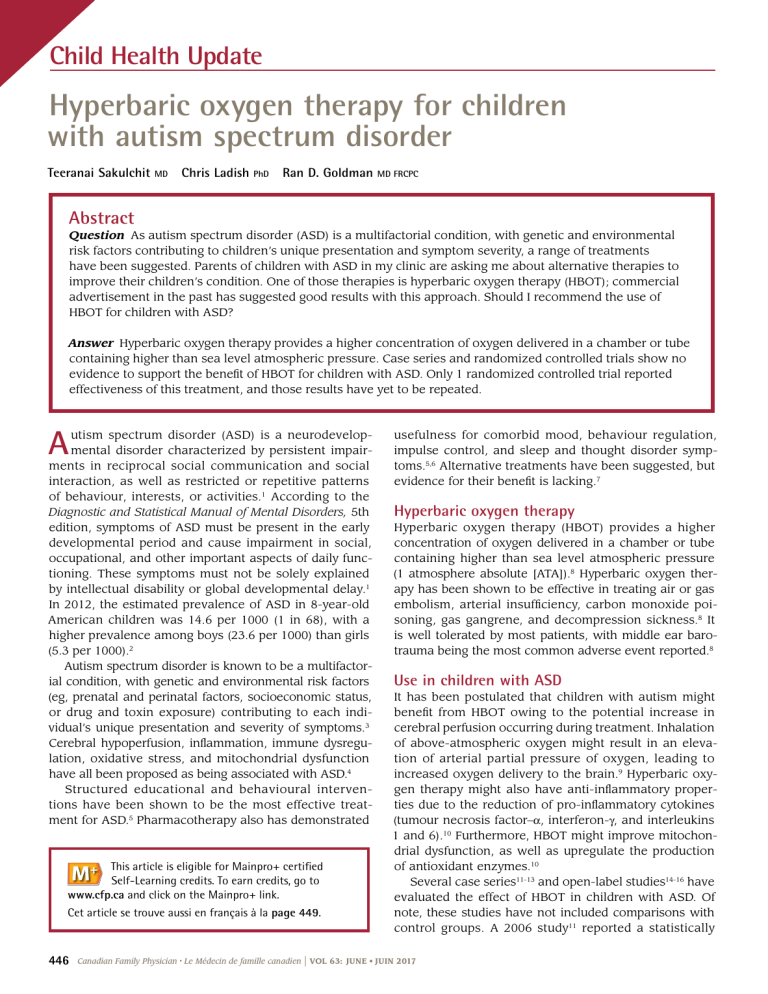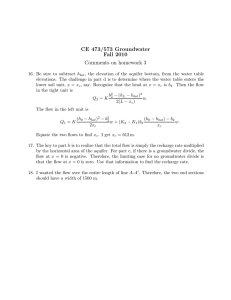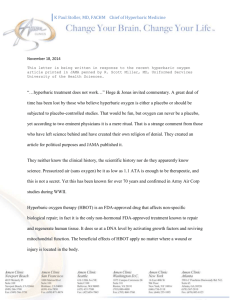
Child Health Update Hyperbaric oxygen therapy for children with autism spectrum disorder Teeranai Sakulchit MD Chris Ladish PhD Ran D. Goldman MD FRCPC Abstract Question As autism spectrum disorder (ASD) is a multifactorial condition, with genetic and environmental risk factors contributing to children’s unique presentation and symptom severity, a range of treatments have been suggested. Parents of children with ASD in my clinic are asking me about alternative therapies to improve their children’s condition. One of those therapies is hyperbaric oxygen therapy (HBOT); commercial advertisement in the past has suggested good results with this approach. Should I recommend the use of HBOT for children with ASD? Answer Hyperbaric oxygen therapy provides a higher concentration of oxygen delivered in a chamber or tube containing higher than sea level atmospheric pressure. Case series and randomized controlled trials show no evidence to support the benefit of HBOT for children with ASD. Only 1 randomized controlled trial reported effectiveness of this treatment, and those results have yet to be repeated. A utism spectrum disorder (ASD) is a neurodevelopmental disorder characterized by persistent impairments in reciprocal social communication and social interaction, as well as restricted or repetitive patterns of behaviour, interests, or activities.1 According to the Diagnostic and Statistical Manual of Mental Disorders, 5th edition, symptoms of ASD must be present in the early developmental period and cause impairment in social, occupational, and other important aspects of daily functioning. These symptoms must not be solely explained by intellectual disability or global developmental delay.1 In 2012, the estimated prevalence of ASD in 8-year-old American children was 14.6 per 1000 (1 in 68), with a higher prevalence among boys (23.6 per 1000) than girls (5.3 per 1000).2 Autism spectrum disorder is known to be a multifactorial condition, with genetic and environmental risk factors (eg, prenatal and perinatal factors, socioeconomic status, or drug and toxin exposure) contributing to each individual’s unique presentation and severity of symptoms.3 Cerebral hypoperfusion, inflammation, immune dysregulation, oxidative stress, and mitochondrial dysfunction have all been proposed as being associated with ASD.4 Structured educational and behavioural interventions have been shown to be the most effective treatment for ASD.5 Pharmacotherapy also has demonstrated This article is eligible for Mainpro+ certified Self-Learning credits. To earn credits, go to www.cfp.ca and click on the Mainpro+ link. Cet article se trouve aussi en français à la page 449. 446 Canadian Family Physician • Le Médecin de famille canadien usefulness for comorbid mood, behaviour regulation, impulse control, and sleep and thought disorder symptoms.5,6 Alternative treatments have been suggested, but evidence for their benefit is lacking.7 Hyperbaric oxygen therapy Hyperbaric oxygen therapy (HBOT) provides a higher concentration of oxygen delivered in a chamber or tube containing higher than sea level atmospheric pressure (1 atmosphere absolute [ATA]).8 Hyperbaric oxygen therapy has been shown to be effective in treating air or gas embolism, arterial insufficiency, carbon monoxide poisoning, gas gangrene, and decompression sickness.8 It is well tolerated by most patients, with middle ear barotrauma being the most common adverse event reported.8 Use in children with ASD It has been postulated that children with autism might benefit from HBOT owing to the potential increase in cerebral perfusion occurring during treatment. Inhalation of above-atmospheric oxygen might result in an elevation of arterial partial pressure of oxygen, leading to increased oxygen delivery to the brain.9 Hyperbaric oxygen therapy might also have anti-inflammatory properties due to the reduction of pro-inflammatory cytokines (tumour necrosis factor–α, interferon-γ, and interleukins 1 and 6).10 Furthermore, HBOT might improve mitochondrial dysfunction, as well as upregulate the production of antioxidant enzymes.10 Several case series11-13 and open-label studies14-16 have evaluated the effect of HBOT in children with ASD. Of note, these studies have not included comparisons with control groups. A 2006 study11 reported a statistically | Vol 63: JUNE • JUIN 2017 Child Health Update significant improvement in the clinical symptoms of 6 autistic children between the ages of 2 and 7 after 40 1-hour sessions of HBOT (1.3 ATA and 28% to 30% oxygen), based on parent ratings. Another case series concluded that about three-quarters of 7 Thai children with autism between the ages of 5 and 9 showed improvements in all of 5 domains assessed (social development, fine motor and eye-hand coordination, language development, gross motor development, and self-help skills) following 10 sessions of HBOT (1.3 ATA and 100% oxygen).12 While the above studies show support for the use of HBOT in children with autism, a growing amount of literature has suggested that there are insufficient data to support the use of HBOT as an effective mode of treatment. Lerman et al13 evaluated the efficacy of HBOT in the treatment of 3 children aged 6 to 7 diagnosed with autism who were also receiving intensive behavioural intervention. Following 40 1-hour sessions of HBOT (1.3 ATA with 88% [± 3 %] oxygen), only 1 child experienced improvement in task engagement and spontaneous communication, while 2 children experienced minimal change from baseline performance. Although all of the participants demonstrated a gradual decrease in problem behaviour, there was no demonstrable improvement noted for HBOT as compared with behaviour therapy. A similar lack of compelling evidence was also noted in an open-label study evaluating 16 children with ASD aged 3 to 10 throughout 40 HBOT sessions at 24% oxygen and 1.3 ATA.14 Quantity of adaptive behaviour, stereotypy, and aberrant behaviour were charted graphically from baseline through completion of HBOT for each participant. Based on visual inspection of the level, trend, and variability of graphed data, the researchers concluded that no marked improvement was demonstrated in any of the types of behaviour after treatment with HBOT. Several studies have measured inflammation and oxidative stress changes before and after HBOT in children with autism. Rossignol et al15 evaluated 18 children 3 to 16 years of age with autism who underwent 45 minutes each of HBOT at either 1.5 ATA and 100% oxygen or at 1.3 ATA and 24% oxygen for a total of 40 sessions. Markers of oxidative stress, including plasma oxidized glutathione before and after treatment, did not change significantly in either group. Both groups demonstrated improvement trends in mean C-reactive protein (CRP) levels, especially children who had higher CRP levels at the onset of treatment. When results for all 18 children were pooled, a significant improvement in CRP levels was found (P = .021). Clinical outcome ratings by parents before and after treatment also showed statistically significant improvement. Bent et al16 studied cytokine level changes before and after 80 sessions of HBOT in 10 children aged 3 to 8. All children reportedly experienced improvements based on several parentcompleted measures of behaviour. However, these children did not have abnormal cytokine levels at baseline, and no statistically significant changes were noted in any of the 29 measured cytokines over the course of the study. Limitations. Scientific evidence in the area is lacking. Studies to date are either case series or open-label trials with a small sample size, limited data analysis, and absence of a comparison group. In some studies, children were allowed to continue and initiate treatments other than HBOT during the study phase including behavioural intervention or antioxidant supplements; these might have contributed to clinical improvement trends and limited the ability to conclude that improvements were related to HBOT. Moreover, parents were not blinded to their children receiving HBOT, and clinical improvements were judged using parent-rating scales rather than blinded before-and-after assessments by clinicians with expertise in diagnosing and rating symptoms of autism. Rater bias might thus have influenced the positive results. Finally, in the absence of a control or placebo group, it is impossible to confirm that any documented improvements were the direct result of HBOT. Randomized controlled trials. The following randomized controlled studies were conducted and help minimize previous study limitations. A trial from Thailand assigned 60 children aged 3 to 9 diagnosed with ASD to receive 20 1-hour sessions of either HBOT (1.5 ATA and 100% oxygen) or a sham treatment (1.15 ATA and 21% oxygen) on consecutive weekdays throughout a 10-week period.17 Following HBOT treatment, participants’ amount of social interaction and communication, behavioural problems, communication and linguistic abilities, and cognitive function were rated by both parents and trained clinicians using the Autism Treatment Evaluation Checklist (ATEC). There were no significant differences found in either the parent- or cliniciancompleted ATEC findings when comparing children who had received HBOT with those who had received placebo treatment. No overall benefit from HBOT was found. A systematic review by Ghanizadeh18 found conflicting results when reviewing 2 randomized controlled trials with a total of 89 participants with autistic disorder.19,20 The first study from the United States19 included children 2 to 14 years of age. Sixteen children received HBOT with 1.3 ATA and 24% to 28% oxygen while 18 children received control treatment consisting of free airflow through the chamber at ambient pressure for 80 sessions of 1 hour each. Following completion of treatment and placebo conditions, all children were rated on the Social Responsiveness Scale. Analysis of data comparing scores on the Social Responsiveness Scale for both conditions found no significant difference between groups in social awareness, social cognition, social communication, or social motivation Vol 63: JUNE • JUIN 2017 | Canadian Family Physician • Le Médecin de famille canadien 447 Child Health Update (all P values of > .05). Consistently, no significant differences were found based on direct observations or ratings of communication, socialization, and total scores on the Autism Diagnostic Observation Schedule—Generic tool. In contrast to the study by Granpeesheh et al,19 another multicentre, randomized controlled study in the United States20 compared 33 children receiving HBOT at 1.3 ATA and 24% oxygen with 29 children in a control group who received 1.03 ATA and 21% oxygen for 40 sessions of 1 hour each over 4 weeks. All children included in this study were diagnosed with autism and were between the ages of 2 and 7. The sample included 52 boys and 10 girls. Children with pervasive developmental disorder not otherwise specified, Asperger syndrome, seizure disorder, current ear infection, uncontrolled asthma, inability to equalize ear pressure, and fragile X syndrome, as well as those receiving ongoing treatment with chelation medication, were excluded from the study. Mean physician-rated Clinical Global Impression (CGI) scores significantly improved in the HBOT group compared with the control group in overall functioning (P = .0008), receptive language (P < .0001), social interaction (P = .0473), and eye contact (P = .0102). Thirty percent of children in the HBOT group were rated as “very much improved” or “much improved” after treatment compared with 8% of children in the control group (P = .0471). An improvement on the CGI scale (score of 1, 2, or 3) was noted in 80% of children in the HBOT group compared with 38% in the control group (P = .0024). Moreover, mean parent-rated CGI scores also improved significantly in the HBOT group compared with the control group in overall functioning (P = .0336), receptive language (P = .0168), and eye contact (P = .0322). Statistically significant improvement in behaviour was noted between pretreatment and posttreatment comparisons on the Aberrant Behaviour Checklist for the HBOT group in total score, irritability, stereotypy, hyperactivity, and speech (P < .03 for each), while those improvements were not significant in the control group. On the ATEC, significant improvement was seen in the HBOT group compared with the control group in terms of sensory or cognitive awareness (P = .0367). Recommendation Hyperbaric oxygen therapy has been approved for treating specific conditions such as decompression sickness. The current absence of conclusive evidence for treatment of autism symptoms has not supported its endorsement for use in treating ASD by the Food and Drug Administration. Further, the Food and Drug Administration has published a warning for parents to beware of false or misleading claims about HBOT for treating autism.21 Conclusion Currently, there is insufficient evidence to support use of HBOT to treat children with ASD, and its use as a form of treatment is not recommended. More research 448 Canadian Family Physician • Le Médecin de famille canadien might reveal specific groups of children who might benefit from such treatment. Competing interests None declared Correspondence Dr Ran D. Goldman; e-mail rgoldman@cw.bc.ca References 1. American Psychiatric Association. Diagnostic and statistical manual of mental disorders. 5th ed. Arlington, VA: American Psychiatric Association; 2013. 2. Christensen DL, Baio J, Van Naarden Braun K, Bilder D, Charles J, Constantino JN, et al. Prevalence and characteristics of autism spectrum disorder among children aged 8 years—Autism and Developmental Disabilities Monitoring Network, 11 sites, United States, 2012. MMWR Surveill Summ 2016;65(3):1-23. 3. Chaste P, Leboyer M. Autism risk factors: genes, environment, and geneenvironment interactions. Dialogues Clin Neurosci 2012;14(3):281-92. 4. Rossignol DA, Frye RE. A review of research trends in physiological abnormalities in autism spectrum disorders: immune dysregulation, inflammation, oxidative stress, mitochondrial dysfunction and environmental toxicant exposures. Mol Psychiatry 2012;17(4):389-401. Epub 2011 Dec 6. 5. Volkmar F, Siegel M, Woodbury-Smith M, King B, McCracken J, State M. Practice parameter for the assessment and treatment of children and adolescents with autism spectrum disorder. J Am Acad Child Adolesc Psychiatry 2014;53(2):237-57. 6. LeClerc S, Easley D. Pharmacological therapies for autism spectrum disorder: a review. P T 2015;40(6):389-97. 7. Levy SE, Hyman SL. Complementary and alternative medicine treatments for children with autism spectrum disorders. Child Adolesc Psychiatr Clin N Am 2015;24(1):117-43. Epub 2014 Oct 3. 8. Weaver LK, editor. Hyperbaric oxygen therapy indications. 13th ed. North Palm Beach, FL: Best Publishing Company; 2014. 9. Calvert JW, Cahill J, Zhang JH. Hyperbaric oxygen and cerebral physiology. Neurol Res 2007;29(2):132-41. 10. Rossignol DA, Bradstreet JJ, Vwwan Dyke K, Schneider C, Freedenfeld SH, O’Hara N, et al. Hyperbaric oxygen treatment in autism spectrum disorders. Med Gas Res 2012;2(1):16. 11. Rossignol DA, Rossignol LW. Hyperbaric oxygen therapy may improve symptoms in autistic children. Med Hypotheses 2006;67(2):216-28. Epub 2006 Mar 22. 12. Chungpaibulpatana J, Sumpatanarax T, Thadakul N, Chantharatreerat C, Konkaew M, Aroonlimsawas M. Hyperbaric oxygen therapy in Thai autistic children. J Med Assoc Thai 2008;91(8):1232-8. 13. Lerman DC, Sansbury T, Hovanetz A, Wolever E, Garcia A, O’Brien E, et al. Using behavior analysis to examine the outcomes of unproven therapies: an evaluation of hyperbaric oxygen therapy for children with autism. Behav Anal Pract 2008;1(2):50-8. 14. Jepson B, Granpeesheh D, Tarbox J, Olive ML, Stott C, Braud S, et al. Controlled evaluation of the effects of hyperbaric oxygen therapy on the behavior of 16 children with autism spectrum disorders. J Autism Dev Disord 2011;41(5):575-88. 15. Rossignol DA, Rossignol LW, James SJ, Melnyk S, Mumper E. The effects of hyperbaric oxygen therapy on oxidative stress, inflammation, and symptoms in children with autism: an open-label pilot study. BMC Pediatr 2007;7:36. 16. Bent S, Bertoglio K, Ashwood P, Nemeth E, Hendren RL. Brief report: hyperbaric oxygen therapy (HBOT) in children with autism spectrum disorder: a clinical trial. J Autism Dev Disord 2012;42(6):1127-32. 17. Sampanthavivat M, Singkhwa W, Chaiyakul T, Karoonyawanich S, Ajpru H. Hyperbaric oxygen in the treatment of childhood autism: a randomised controlled trial. Diving Hyperb Med 2012;42(3):128-33. 18. Ghanizadeh A. Hyperbaric oxygen therapy for treatment of children with autism: a systematic review of randomized trials. Med Gas Res 2012;2:13. 19. Granpeesheh D, Tarbox J, Dixon DR, Wilke AE, Allen MS, Bradstreet JJ. Randomized trial of hyperbaric oxygen therapy for children with autism. Res Autism Spectr Disord 2010;4:268-75. 20. Rossignol DA, Rossignol LW, Smith S, Schneider C, Logerquist S, Usman A, et al. Hyperbaric treatment for children with autism: a multicenter, randomized, double-blind, controlled trial. BMC Pediatr 2009;9:21. 21. Food and Drug Administration [website]. Beware of false or misleading claims for treating autism. Silver Spring, MD: Food and Drug Administration; 2017. Available from: www.fda.gov/ForConsumers/ConsumerUpdates/ucm394757.htm. Accessed 2017 Apr 12. Child Health Update is produced by the Pediatric Research in Emergency Therapeutics (PRETx) program (www. pretx.org) at the BC Children’s Hospital in Vancouver, BC. Drs Sakulchit and Ladish are members and Dr Goldman is Director of the PRETx program. The mission of the PRETx program is to promote child health through evidence-based research in therapeutics in pediatric emergency medicine. Do you have questions about the effects of drugs, chemicals, radiation, or infections in children? We invite you to submit them to the PRETx program by fax at 604 875-2414; they will be addressed in future Child Health Updates. Published Child Health Updates are available on the Canadian Family Physician website (www.cfp.ca). | Vol 63: JUNE • JUIN 2017 Pediatric Research in Emergency Therapeutics



